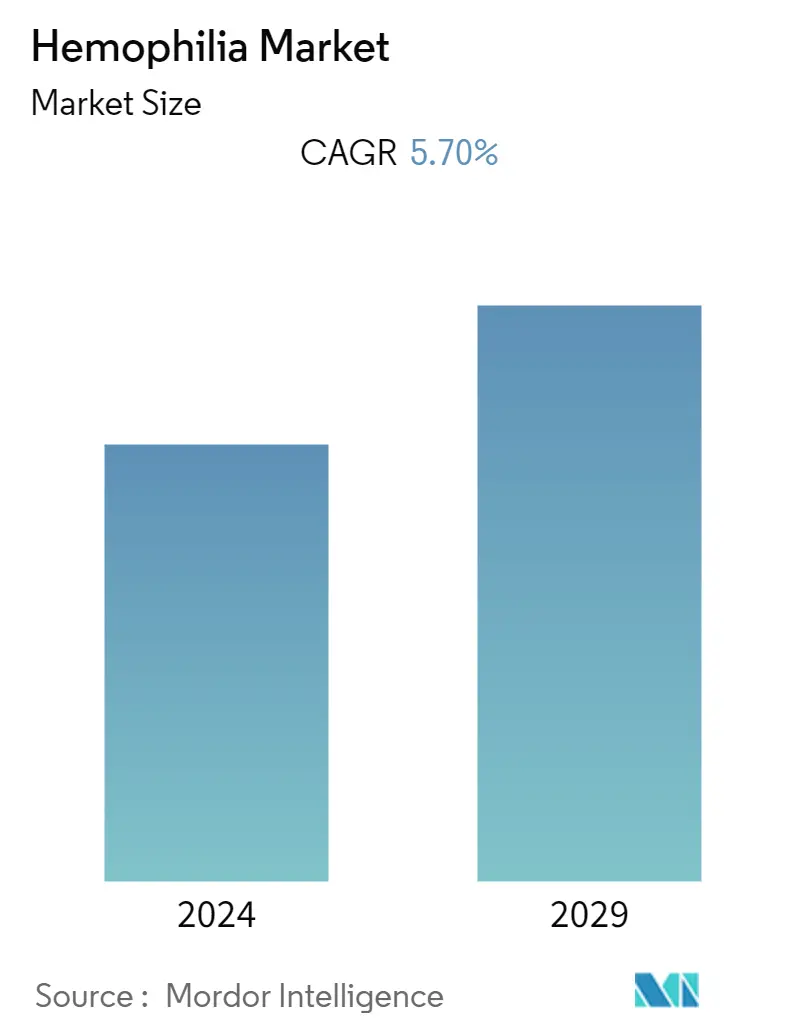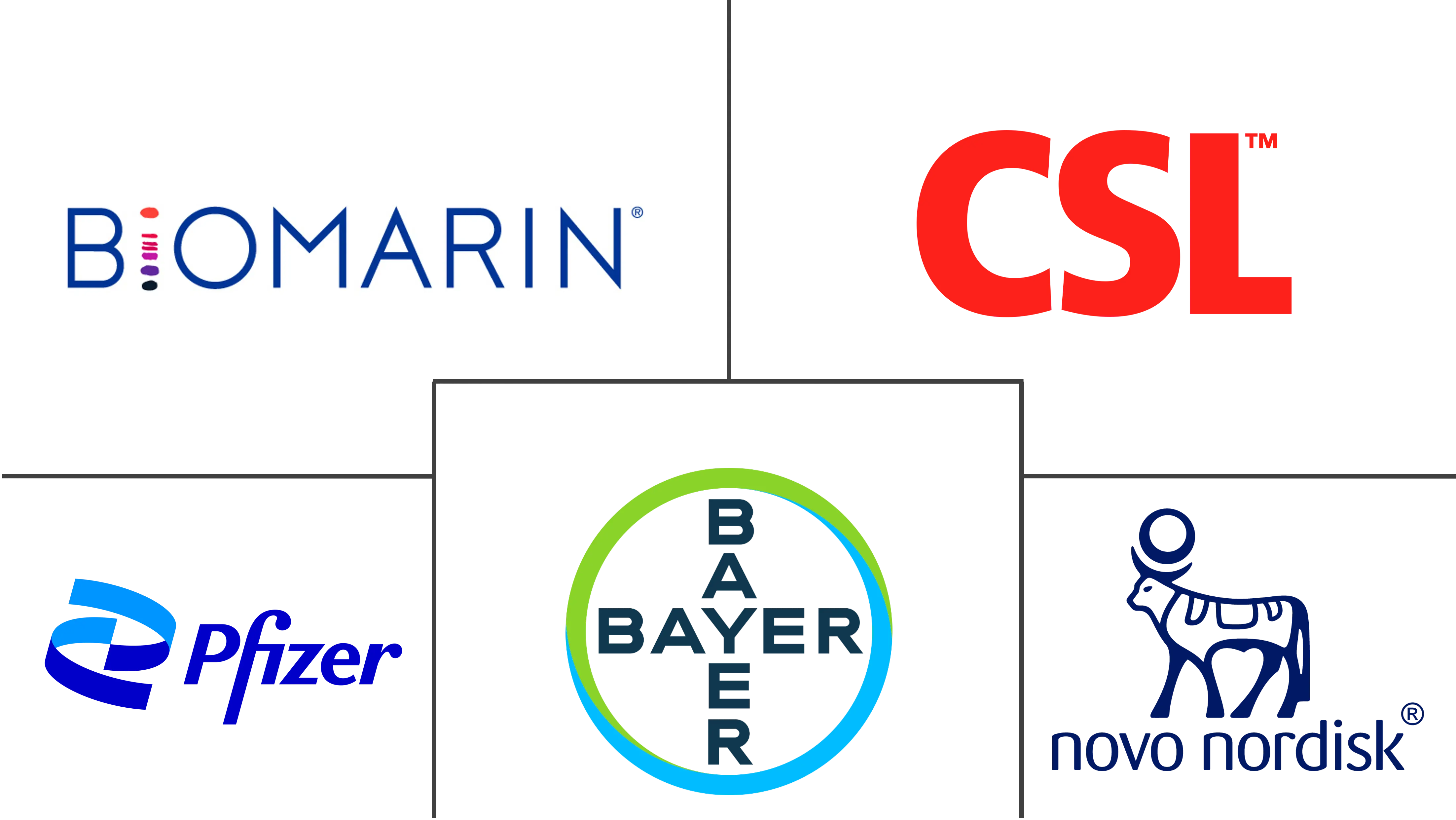Market Size of Hemophilia Industry

| Study Period | 2019 - 2029 |
| Base Year For Estimation | 2023 |
| Forecast Data Period | 2024 - 2029 |
| CAGR | 5.70 % |
| Fastest Growing Market | Asia Pacific |
| Largest Market | North America |
Major Players
*Disclaimer: Major Players sorted in no particular order |
Hemophilia Market Analysis
The hemophilia market is expected to register a CAGR of 5.7% during the forecast period.
The outbreak of COVID-19 adversely impacted individuals with chronic medical conditions, such as hemophilia. They had to take extra precautions to minimize the risk of contracting COVID-19, as this population group was more prone to infectious diseases. In addition, according to the study published in the Journal of Dental and Medical Sciences in August 2020, the mean annualized bleed rate before the lockdown was 2.4. In contrast, it significantly increased to 8.2 during the lockdown in children who were on regular prophylaxis earlier. Among various reasons cited by them for not attending a Hemophilia treatment center, the important reasons were non-availability of transport (97.5%), fear of coronavirus infection (95%), and high cost of alternate transport (90%). It slowed down the market growth during the pandemic. However, since the pandemic restriction was eased and the rise in availability of advanced therapies for hemophilia, the studied market is likely to grow notably in the coming years.
Certain factors driving the market growth include the growing prevalence of hemophilia, favorable government initiatives, and rising research and development. For instance, according to the World Federation of Hemophilia Global Report 2021, there were 386,966 people with bleeding disorders identified globally, of which 233,577 cases were hemophilia. Such a huge prevalence of hemophilia globally will likely lead to increased adoption of therapies for hemophilia, driving market growth.
Additionally, an increase in grants for research on hemophilia is expected to contribute to the market studied over the forecast period. For instance, in March 2022, a researcher from the Indiana University School of Medicine received USD 2 million from the National Heart Lung and Blood Institute. It is for developing three major themes in a gene therapy approach that could lead to safer and potentially curative treatments for hemophilia. It will lead to the development of novel therapies for hemophilia, thereby expected to drive market growth over the forecast period. Moreover, rising product approvals for the United States Food and Drug Administration are expected to propel the market growth. For instance, in March 2022, Freeline Therapeutics Holdings plc dosed the first patient in its Phase 1/2 B-LIEVE dose-confirmation clinical trial of FLT180a for treating hemophilia B. It is a debilitating genetic bleeding disorder caused by a clotting factor IX protein deficiency.
Thus, due to the rise in hemophilia cases and the increase in product launches coupled with research and development for hemophilia therapies, the studied market is expected to witness significant market growth over the forecast period. However, the high cost of hemophilia treatment and the need for more awareness among people regarding advanced technologies is expected to hinder the studied market.
Hemophilia Industry Segmentation
As per the scope of the report, hemophilia is a genetic bleeding disorder that prevents the blood from clotting normally due to a lack of enough blood-clotting proteins (clotting factors). People with hemophilia contain low levels of either factor VIII (8) or factor IX (9). The primary symptom is uncontrolled, often spontaneous bleeding in different body areas. The amount of bleeding depends on the severity of hemophilia. The Hemophilia Market is segmented by disease type (Hemophilia A, Hemophilia B, and others), therapy (replacement therapy, gene therapy, and others), product type (recombinant coagulation factor concentrates, plasma-derived coagulation factor concentrates, and others), and Geography (North America, Europe, Asia-Pacific, Middle East and Africa, and South America). The report also covers the estimated market sizes and trends for 17 countries across major regions globally. The report offers the value (in USD) for the above segments.
| By Disease Type | |
| Hemophilia A | |
| Hemophilia B | |
| Others |
| By Therapy | |
| Replacement Therapy | |
| Gene Therapy | |
| Others |
| By Product Type | |
| Recombinant Coagulation Factor Concentrates | |
| Plasma-derived Coagulation Factor Concentrates | |
| Others |
| Geography | ||||||||
| ||||||||
| ||||||||
| ||||||||
| ||||||||
|
Hemophilia Market Size Summary
The hemophilia market is poised for significant growth, driven by an increasing prevalence of the disorder and advancements in treatment therapies. The market is experiencing a resurgence following the challenges posed by the COVID-19 pandemic, which had previously hindered growth due to increased health risks and logistical challenges for patients. The availability of advanced therapies and favorable government initiatives are contributing to the market's expansion. Research and development efforts, including substantial grants for gene therapy advancements, are expected to further propel the market. The introduction of novel therapies and product approvals, particularly in the United States, is anticipated to enhance treatment options and drive market dynamics.
Hemophilia A, the most common severe bleeding disorder, is expected to hold a significant market share due to its high prevalence and the development of various therapies. The market is characterized by moderate competition, with key players engaging in strategic alliances and product launches to strengthen their market position. North America is projected to maintain a substantial market share, supported by increasing awareness, favorable regional policies, and ongoing research initiatives. The market's growth trajectory is also bolstered by regulatory approvals and the introduction of innovative treatments, which are expected to address the needs of patients and enhance therapeutic outcomes.
Hemophilia Market Size - Table of Contents
-
1. MARKET DYNAMICS
-
1.1 Market Overview
-
1.2 Market Drivers
-
1.2.1 Growing Prevalence of Hemophilia
-
1.2.2 Favorable Government Initiatives
-
1.2.3 Rising R&D and New Product Development
-
-
1.3 Market Restraints
-
1.3.1 High Cost of Treatment
-
1.3.2 Lack of Awareness Regarding Advanced Technologies
-
-
1.4 Porter's Five Forces Analysis
-
1.4.1 Bargaining Power of Suppliers
-
1.4.2 Bargaining Power of Buyers/Consumers
-
1.4.3 Threat of New Entrants
-
1.4.4 Threat of Substitute Products
-
1.4.5 Intensity of Competitive Rivalry
-
-
-
2. MARKET SEGMENTATION (Market Size by Value - USD)
-
2.1 By Disease Type
-
2.1.1 Hemophilia A
-
2.1.2 Hemophilia B
-
2.1.3 Others
-
-
2.2 By Therapy
-
2.2.1 Replacement Therapy
-
2.2.2 Gene Therapy
-
2.2.3 Others
-
-
2.3 By Product Type
-
2.3.1 Recombinant Coagulation Factor Concentrates
-
2.3.2 Plasma-derived Coagulation Factor Concentrates
-
2.3.3 Others
-
-
2.4 Geography
-
2.4.1 North America
-
2.4.1.1 United States
-
2.4.1.2 Canada
-
2.4.1.3 Mexico
-
-
2.4.2 Europe
-
2.4.2.1 Germany
-
2.4.2.2 United Kingdom
-
2.4.2.3 France
-
2.4.2.4 Italy
-
2.4.2.5 Spain
-
2.4.2.6 Rest of Europe
-
-
2.4.3 Asia-Pacific
-
2.4.3.1 China
-
2.4.3.2 Japan
-
2.4.3.3 India
-
2.4.3.4 Australia
-
2.4.3.5 South Korea
-
2.4.3.6 Rest of Asia-Pacific
-
-
2.4.4 Middle East and Africa
-
2.4.4.1 GCC
-
2.4.4.2 South Africa
-
2.4.4.3 Rest of Middle East and Africa
-
-
2.4.5 South America
-
2.4.5.1 Brazil
-
2.4.5.2 Argentina
-
2.4.5.3 Rest of South America
-
-
-
Hemophilia Market Size FAQs
What is the current Global Hemophilia Market size?
The Global Hemophilia Market is projected to register a CAGR of 5.70% during the forecast period (2024-2029)
Who are the key players in Global Hemophilia Market?
Pfizer, Inc., Bayer AG, Novo Nordisk A/S, CSL Limited (CSL Behring) and BioMarin are the major companies operating in the Global Hemophilia Market.

